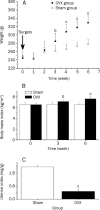GC-TOF/MS-based metabolomic profiling of estrogen deficiency-induced obesity in ovariectomized rats
- PMID: 21293480
- PMCID: PMC4009941
- DOI: 10.1038/aps.2010.196
GC-TOF/MS-based metabolomic profiling of estrogen deficiency-induced obesity in ovariectomized rats
Abstract
Aim: To explore the alteration of endogenous metabolites and identify potential biomarkers using metabolomic profiling with gas chromatography coupled a time-of-flight mass analyzer (GC/TOF-MS) in a rat model of estrogen-deficiency-induced obesity.
Methods: Twelve female Sprague-Dawley rats six month of age were either sham-operated or ovariectomized (OVX). Rat blood was collected, and serum was analyzed for biomarkers using standard colorimetric methods with commercial assay kits and a metabolomic approach with GC/TOF-MS. The data were analyzed using multivariate statistical techniques.
Results: A high body weight and body mass index inversely correlated with serum estradiol (E2) in the OVX rats compared to the sham rats. Estrogen deficiency also significantly increased serum total cholesterol, triglycerides, and low-density lipoprotein cholesterol. Utilizing GC/TOF-MS-based metabolomic analysis and the partial least-squares discriminant analysis, the OVX samples were discriminated from the shams. Elevated levels of cholesterol, glycerol, glucose, arachidonic acid, glutamic acid, glycine, and cystine and reduced alanine levels were observed. Serum glucose metabolism, energy metabolism, lipid metabolism, and amino acid metabolism were involved in estrogen-deficiency-induced obesity in OVX rats.
Conclusion: The series of potential biomarkers identified in the present study provided fingerprints of rat metabolomic changes during obesity and an overview of multiple metabolic pathways during the progression of obesity involving glucose metabolism, lipid metabolism, and amino acid metabolism.
Figures




References
-
- Haslam DW, James WP. Obesity. Lancet. 2005;366:1197–209. - PubMed
-
- Ryan AS, Nicklas BJ, Berman DM. Hormone replacement therapy, insulin sensitivity, and abdominal obesity in postmenopausal women. Diabetes Care. 2002;25:127–33. - PubMed
-
- Winter Y, Rohrmann S, Linseisen J, Lanczik O, Ringleb PA, Hebebrand J, et al. Contribution of obesity and abdominal fat mass to risk of stroke and transient ischemic attacks. Stroke. 2008;39:3145–51. - PubMed
-
- Kirschner MA, Ertel N, Schneider G. Obesity, hormones, and cancer. Cancer Res. 1981;41:3711–7. - PubMed
Publication types
MeSH terms
Substances
LinkOut - more resources
Full Text Sources
Medical
Miscellaneous

